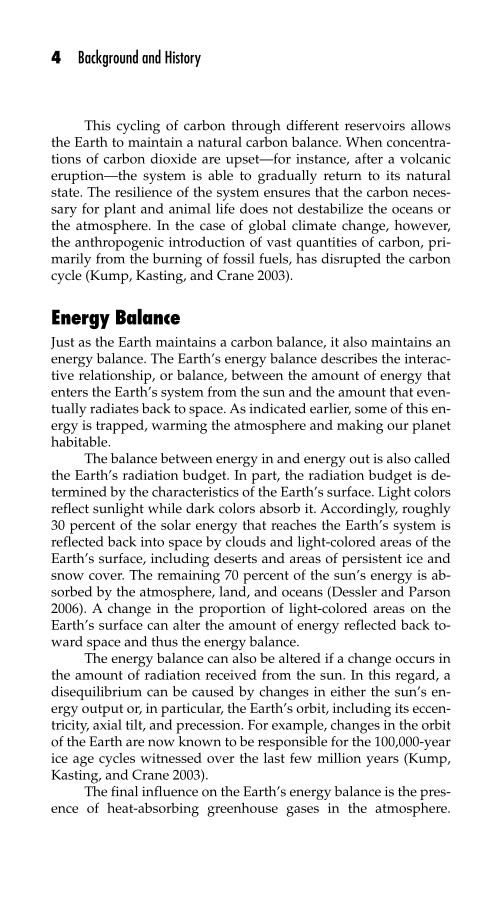4 Background and History This cycling of carbon through different reservoirs allows the Earth to maintain a natural carbon balance. When concentra- tions of carbon dioxide are upset—for instance, after a volcanic eruption—the system is able to gradually return to its natural state. The resilience of the system ensures that the carbon neces- sary for plant and animal life does not destabilize the oceans or the atmosphere. In the case of global climate change, however, the anthropogenic introduction of vast quantities of carbon, pri- marily from the burning of fossil fuels, has disrupted the carbon cycle (Kump, Kasting, and Crane 2003). Energy Balance Just as the Earth maintains a carbon balance, it also maintains an energy balance. The Earth’s energy balance describes the interac- tive relationship, or balance, between the amount of energy that enters the Earth’s system from the sun and the amount that even- tually radiates back to space. As indicated earlier, some of this en- ergy is trapped, warming the atmosphere and making our planet habitable. The balance between energy in and energy out is also called the Earth’s radiation budget. In part, the radiation budget is de- termined by the characteristics of the Earth’s surface. Light colors reflect sunlight while dark colors absorb it. Accordingly, roughly 30 percent of the solar energy that reaches the Earth’s system is reflected back into space by clouds and light-colored areas of the Earth’s surface, including deserts and areas of persistent ice and snow cover. The remaining 70 percent of the sun’s energy is ab- sorbed by the atmosphere, land, and oceans (Dessler and Parson 2006). A change in the proportion of light-colored areas on the Earth’s surface can alter the amount of energy reflected back to- ward space and thus the energy balance. The energy balance can also be altered if a change occurs in the amount of radiation received from the sun. In this regard, a disequilibrium can be caused by changes in either the sun’s en- ergy output or, in particular, the Earth’s orbit, including its eccen- tricity, axial tilt, and precession. For example, changes in the orbit of the Earth are now known to be responsible for the 100,000-year ice age cycles witnessed over the last few million years (Kump, Kasting, and Crane 2003). The final influence on the Earth’s energy balance is the pres- ence of heat-absorbing greenhouse gases in the atmosphere.
Document Details My Account Print multiple pages
Print
You have printed 0 times in the last 24 hours.
Your print count will reset on at .
You may print 0 more time(s) before then.
You may print a maximum of 0 pages at a time.




































































































































































































































































































































































